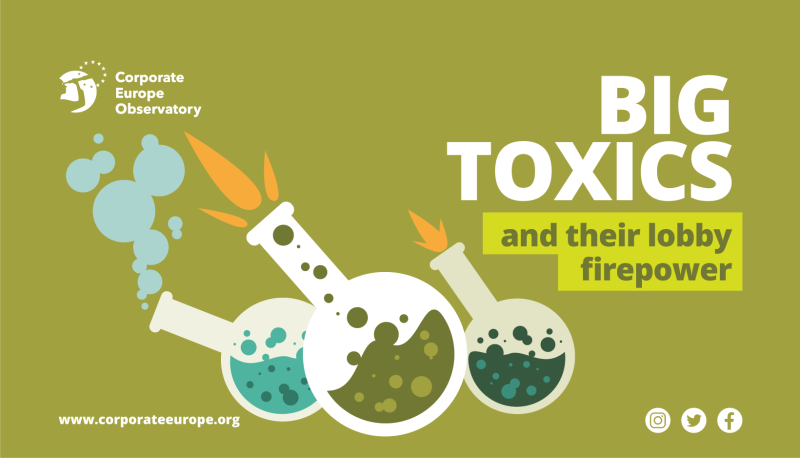
Big Toxics and their lobby firepower
Welcome to the lobby firepower of Big Toxics in Brussels! Highlights include the postponement of the revision of the REACH regulation on chemicals; the start of a pushback on the proposed ban of ‘forever chemicals’ PFAS; and plans to cut pesticide use by 50 per cent by 2030 and to stop the export of banned chemicals, both of which have gone missing in action.
Lobby firepower
New analysis based on LobbyFacts data Sidenote LobbyFacts is a project of Corporate Europe Observatory and LobbyControl and it provides handy tools to search, sort, compare, and analyse official EU lobby transparency register data – from today and dating back to 2012 – to help journalists and researchers track lobbyists and their influence at the EU level. has demonstrated that of the highest-spending 50 lobbies in the EU lobby transparency register, major chemical industry players ‒ Big Toxics ‒ spend more than either Big Tech or Big Energy in lobbying the EU institutions.
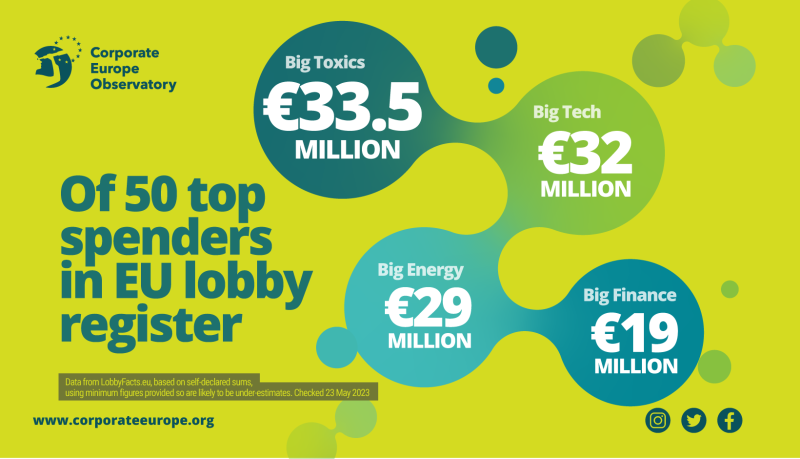
The most recent self-declared figures show that there are 7 Big Toxic lobbies in the top 50 of the highest-spenders on EU lobbying: 4 companies (Bayer, ExxonMobil Petroleum & Chemical, Dow Europe, and BASF) and 3 trade associations (the EU chemical industry lobby CEFIC, its German equivalent Verband der Chemischen Industrie (VCI), and Plastics Europe). Together they declare spending €33.5 million lobbying the EU institutions in the most recent year for which figures are available. You can check out our recent profile of BASF here.
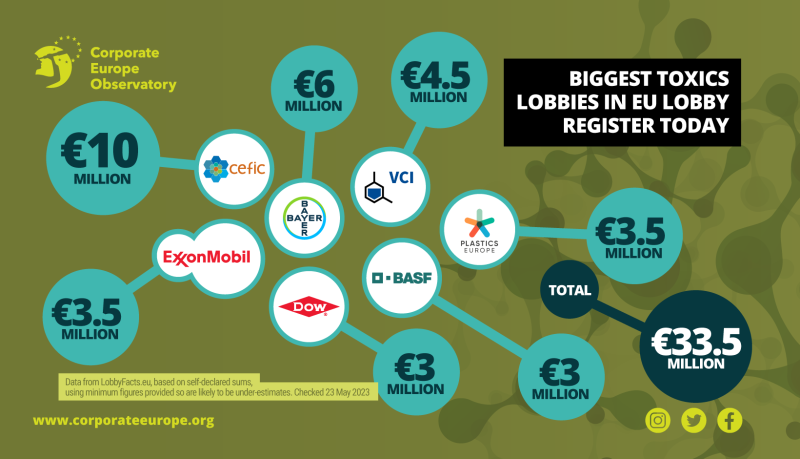
Looking at the past decade, LobbyFacts data indicates that these 7 Big Toxics have declared a total lobby spend of €293 million. These 7 corporate lobbies have also enjoyed 495 European Parliament access passes and 249 meetings (since December 2014) with the highest levels of the European Commission. Of these 7 lobbies, 3 (BASF, Bayer, and VCI) are German.
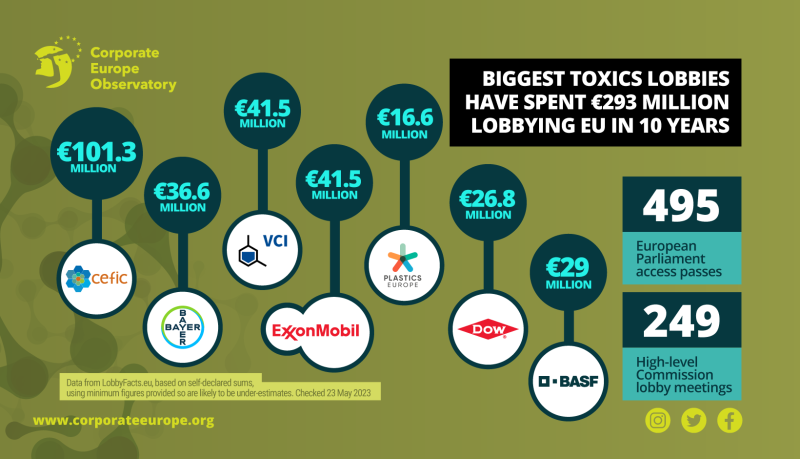
This week the Financial Times has also reported on the firepower of the lobby against PFAS, also known as ‘forever chemicals’. Sidenote According to the European Chemicals Agency, per- and polyfluoroalkyl substances (PFAS) are a large class of thousands of synthetic chemicals that are used throughout society. They contain carbon-fluorine bonds, which are one of the strongest chemical bonds in organic chemistry. This means that they resist degradation. https://echa.europa.eu/hot-topics/perfluoroalkyl-chemicals-pfas It highlighted how a quarter of companies which declare spending €3 million or more annually on EU lobbying are “leading chemical producers” – Bayer, Dow Europe, and BASF – and that together they spent €12 million in 2022, listing either PFAS or REACH Sidenote REACH – the EU’s flagship chemicals regulation from 2007 – is the registration, evaluation, authorisation and restriction of chemicals. It aims to improve the protection of human health and the environment through the better and earlier identification of the intrinsic properties of chemical substances. https://ec.europa.eu/environment/chemicals/reach/reach_en.htm as areas of focus.
Double-counting?
Could it be that there is some double-counting in these figures for the Big Toxics lobby? After all, Bayer, BASF, ExxonMobil, and Dow are members of CEFIC and VCI, and 3 are members of Plastics Europe. Membership fees for lobby organisations should be declared as part of a company’s annual lobby spend, and 3 of the 4 companies state that this is the case. However, to take the case of CEFIC, it declares a lobby spend of €10.4 million for 2022 but a whopping total budget of €41.6 million which it says “comprises roughly 20 M € for management of horizontal programs and 21.6 M € for management of Cefic Sector Groups”. It is not possible, from these figures, to quantify how much the membership fees paid by the 4 companies contribute to CEFIC’s declared lobby spend and would legitimately be double-counting. However, CEFIC says that it has 650 members, not just the handful considered here, and we have used the minimum (rather than maximum) lobby spend figures declared. Any double-counting is unlikely to jeopardise the chemical lobby’s position at or near the top of the LobbyFacts rankings.
Big Toxics’ allies in top 50
In addition to the 7 Big Toxics identified above, of the other 43 highest-declared lobbyists in the top 50 ranking, 15 are consultancies or lobby guns-for-hire. At least 12 of these have significant clients from within the industrial- or agro-chemicals sectors, such as Burson Cohn & Wolfe Sprl which declared receiving €200,000 from PFAS-producer 3M, and FTI Consulting which received at least €300,000 from Honeywell for lobby consultancy work on PFAS.
Also appearing in the top 50 are a further 2 pan-industry lobby groups: BusinessEurope which has supported the postponement of the much-needed REACH regulatory reform, in line with the interests of its corporate members from the chemicals sector, and its German equivalent the Bundesverband der Deutschen Industrie (BDI) which has lobbied the high-level of the Commission on chemicals.
All in all, 21 out of the top 50 highest-spenders in the EU lobby register are actively promoting a corporate-friendly agenda on chemicals policy.
Toxics lobby beyond the top 50
Yet the full lobby firepower of the entire chemicals industry is much, much higher.
Outside of the top 50 highest-spending lobbies, slightly further down the LobbyFacts rankings according to declared annual lobby spend, are many other major chemical industry players: Yara (€2,500,000), Syngenta (€1,250,000), Cosmetics Europe (€1,250,000), Eli Lilly (€900,000), CropLife Europe (€900,000), Ineos (€900,000), Chemours (€900,000), Corteva (€900,000), Covestro (€900,000), Fertilisers Europe (€900,000), Henkel (€800,000), Solvay (€800,000), 3M (€800,000) … the list goes on and on.
Toxics lobbying pays off
In the past four years Brussels has seen an ugly lobby battle play out as corporate lobby groups, from energy to agri-business to chemicals have instrumentalised von der Leyen’s European Green Deal for their own ends. The chemicals component of the Deal, the Chemicals Strategy for Sustainability (CSS), was heavily lobbied before it was launched in October 2020 and, at that time, the Commission’s DG Environment appeared to largely win its internal battle with the industry-friendly DG Grow over its content. But the mood has now shifted within the Commission.
Russia’s appalling, illegal invasion of Ukraine and subsequent price inflation have been used by the toxics industry and their ideological allies in the Conservative EPP group in the European Parliament, and in the Commission, to undermine and delay the much-needed reform of the REACH regulation on chemicals. And just in the past week EU leaders such as President Macron and Prime Minister De Croo have been demanding a ‘green regulatory break’ including questioning the timing for the REACH reform. It seems clear that the Big Toxics lobby agenda is being heard at the very top levels of EU decision-making.
And on the occasions when lobby firepower has not worked, industry can always use its financial muscle and head to the courts. Witness its successful legal challenge to the regulation of “possible carcinogen” titanium dioxide which has tied-up decision-makers with further legal wrangling.
Burden-shifting
When the toxics industry lobbies and litigates to hold-up public interest regulation, it often rebrands such rules as an unnecessary ‘burden’. Yet the real burden comes from the ongoing manufacture and sales of their toxic products – at a huge cost to our health and environment. For PFAS alone, the total health-related costs for exposure across Europe has been estimated at €52-84 billion per year, with impacts likely to include liver damage, decreased fertility, and cancer. A “plausible” figure for European environmental clean-up costs is €10-20 billion. And those are quite aside from the unquantifiable damage and suffering caused by ‘forever chemicals’. Meanwhile French research organisation Le Basic estimated the direct European health and environmental costs of pesticide use added up to around €2.3 billion in 2017.
This attempt at burden-shifting is particularly galling as this is not a struggling sector. The latest Eurostat figures on chemicals shows an industry whose exports have grown by 6 per cent a year since 2002 to a massive €553 billion in 2022. The EU had a growing trade surplus in chemicals throughout the 2002-22 period and last year, 6 member states – including Germany, Belgium, and the Netherlands – exported more than €30 billion of chemicals each outside the EU.
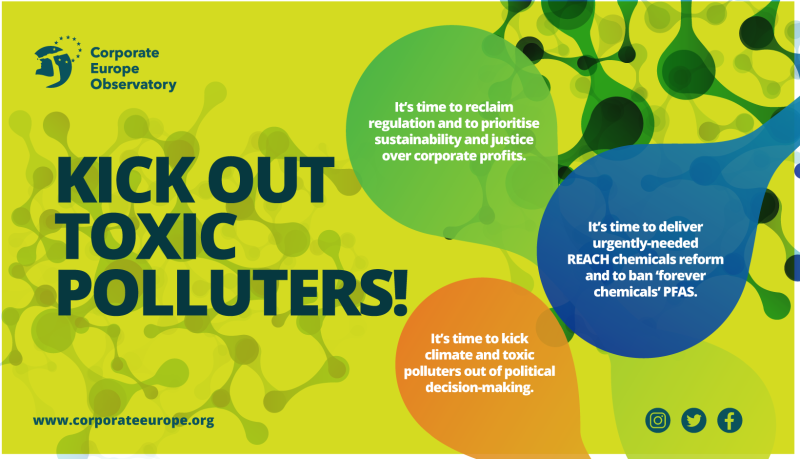
Can pay, won’t pay?
Of course EU lobbying is not always a numbers game. But it is striking to see the huge lobby firepower of the chemicals lobby, as demonstrated in the LobbyFacts data, which in combination with influence from political allies, have achieved a delayed REACH restriction on chemicals, and derailed proposals on pesticides reduction and the export ban.
And as we look ahead to the regulatory debate on the urgent proposal to restrict thousands of PFAS, the firepower of the toxics industry should really worry us.
This industry has deep pockets and can and must be held to account for the toxics legacy in our bodies, soils, air, and waters. Regulation to deal with the past and to prevent future toxic pollution is urgently needed and should be decided on public interest grounds alone. There is a public interest firewall against tobacco industry lobbying on public health matters, and this is now demanded by climate crisis campaigners for the fossil fuel industry, to stop decision-makers from sharing platforms, granting lobby access, and to prevent conflicts of interest.
Shouldn’t we also protect decision-makers from chemical industry lobbying to defend their toxic products? It’s time to kick toxic polluters out of political decision-making.
Our methodology
We identified the 50 highest-spending lobbies in the EU lobby register by removing 11 implausibly large entries Sidenote The EU lobby transparency register has a problem with implausible or dodgy registrations, which is linked to the fact that the register is not legally-binding. More information is available here: https://corporateeurope.org/en/2022/09/complaint-eu-lobby-transparency-register from the LobbyFacts rankings of the highest-declared lobby spenders, and then identifying those with a major interest in chemicals policy – 7 in total, the Big Toxics. Two of these (CEFIC and Exxon) are also considered part of the Big Energy lobby. These 7 declare lobbying on chemicals policies, among other topics. As LobbyFacts holds an archive of data going back to 2012 we were able to calculate a total declared lobby spend for those 7 over the most recent 10 years for which figures were provided. Where lobby spend figures had been declared within a range eg €6-€6.5 million, we took the minimum figure. As a result we argue that these figures are likely to be under-estimates. These figures are self-declared by the lobbyists themselves and not subject to independent verification; the EU lobby register is not legally-binding and lacks significant sanction powers. Sidenote More information about the flaws of the EU lobby transparency register can be found here: https://www.lobbyfacts.eu/about At the time of writing, BASF is the subject of a Corporate Europe Observatory complaint regarding the figures provided in its lobby register entry. As of May 2022, NGOs, as non-commercial organisations, are no longer required to provide a lobby budget and therefore do not appear in the list of the EU’s biggest lobby-spenders. Data correct as of 23 May and is available here or at LobbyFacts.eu
